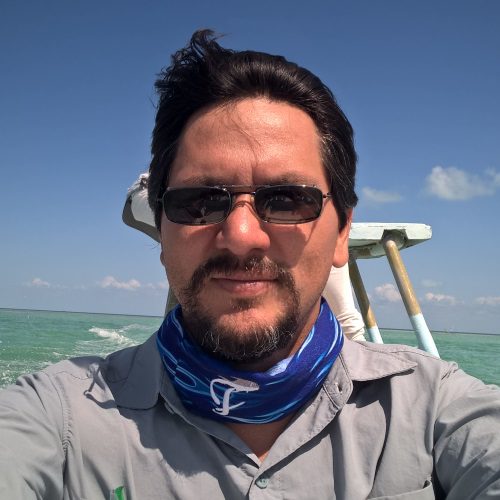Leopoldo Palomo
About
 I was born in Mérida, Yucatán and studied Biology at the Autonomous University of Yucatán. I have had the opportunity to work with a number of environmental organisations including various NGOs working with Marine Turtle Conservation, the National Forest Commission which promotes environmental services in rural communities and the Fisheries Biology Laboratory of Dr. Silvia Salas where I worked with fishery communities and the Research Center and Advanced Studies of the National Polytechnic Institute (CINVESTAV-IPN Unidad Mérida). Dr. Salas has been my mentor and introduced me to the problems concerning fishing communities and their livelihoods.
I was born in Mérida, Yucatán and studied Biology at the Autonomous University of Yucatán. I have had the opportunity to work with a number of environmental organisations including various NGOs working with Marine Turtle Conservation, the National Forest Commission which promotes environmental services in rural communities and the Fisheries Biology Laboratory of Dr. Silvia Salas where I worked with fishery communities and the Research Center and Advanced Studies of the National Polytechnic Institute (CINVESTAV-IPN Unidad Mérida). Dr. Salas has been my mentor and introduced me to the problems concerning fishing communities and their livelihoods.
In 2011, I completed my Master of Science degree in Aquaculture Business Management and pursued a degree Geomatics. I am very interested in how GIS and other remote sensing tools can be used for environmental research.
In August 2015, I started my Ph.D. in Fisheries and Aquaculture Bio-economy at the Marist University of Mérida. I believe fishing communities face major challenges from climate change and overfishing. Many communities know they must work together with government and research institutions to design sustainable management measures.
Place
My project is centered on the recreational fishery on Ascension Bay, Quintana Roo, specifically the fishing community. Their main catch is the spiny lobster (Panulirus argus) which utilizes artificial shelters called casitas (concrete structures placed underwater in the Bay). This community is a great example of good governability, where the fishery cooperative has instituted strict rules concerning fisheries and surveillance during the closed season. They have established Territorial Use Rights in fisheries, called campos and have shown a high degree of self-governance in maintaining a healthy population of spiny lobster and ecosystem conservation.
Punta Allen is located in the Natural Reserve of Sian Kaán, which includes a part of the Mesoamerican Barrier Reef. Ecotourism is very strong in this region, and the community has created tourism cooperatives which offer activities such as fly fishing, snorkeling and boat tours to observe dolphins, seabirds, and turtles.
In Punta Allen recreational fly fishing is a popular sport which began more than 20 years ago. Today the region has many lodges and fishing clubs which are mostly administrated by foreign anglers or in associations with local fisherman. Many of the local fishermen act as guides to foreign anglers. The fly fishing clubs have agreements with the local tourism cooperatives to provide boats and guides for their clients.
There are about 70 boats equipped for fly fishing in the bay, which alternate between fly fishing (December-July) and lobster fishing (July-December). The most important fly fishing species are Permit (Trachinotus falcatus) and bonefish (Albula vulpes). However, there is lack information regarding these species (e.g. stock assessments, economic valuation, life history).
Research
My research is centered on the recreational fishery of Punta Allen, and how the lobster fishermen found an opportunity to work as guides for visiting fly fishermen. The local fishermen take advantage of their knowledge of the Bay to determine the location of game fish. Ascension Bay contains several species in high demand by anglers, including bonefish (Albula vulpes), permit (Trachinotus falcatus), tarpon (Megalops atlanticus) and snook (Centropomus undecimalis). However, the majority of anglers visit the region for the high permit population. Fishing clubs promote Punta Allen as The Permit Capital of the World. New fishing guides learn about fly fishing from older guides and they created agreements to develop methods to conserve and protect the coastal lagoons, with actions such as banning net fishing inside the bay, avoid catching game fish and only allowing the catch and release of game fish.
My research has three objectives; the first is an economic valuation of the recreational fishery in Ascension bay, using a travel cost method by interviewing anglers in one season. The second is to start an annual census of the population of permit and bonefish in the bay by forming a technical team of recreational fly fishing guides. We will rely on a visual census based on a standard line transect visual estimate inside the bay. The third will be a correlation of the main fishing areas with the characteristics of the benthic seafloor, to see if there are patterns in the habitat of populations of bonefish and permit. We hope to find an average estimated number of permit and bonefish stocks in the bay. The community could use this information as an indicator of population and ecosystem health. Additionally, the economic valuation could be useful to promote management policies which encourage the protection and management of recreational fish species.
Key Publications
- Edgar Torres-Irineo, Silvia Salas, Jorge I. Euán-Ávila, Leopoldo Palomo-Cortés. Assessing the spatial distribution of small-scale vessels’ operations from VMS data in the southeastern Mexico.
- Hawksbill turtle (Eretmochelys imbricata Linnaeus 1766) and green turtle (Chelonia mydas Linnaeus 1754) nesting activity (2002-2004) at El Cuyo beach, Mexico


